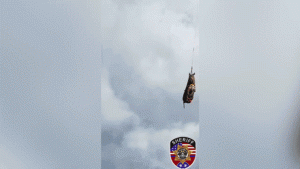Denise Richards’s participation in the demanding reality show “Special Forces: World’s Toughest Test” resulted in a painful and costly injury. While performing a physically challenging task that involved jumping off a bridge, Richards ruptured both of her breast implants. She attributes the rupture to the harness she was wearing during the activity. The injury, which occurred during filming, has yet to be addressed, though Richards plans to undergo corrective surgery. The financial burden of the surgery also falls on Richards, as she believes the show’s liability waivers absolve them of responsibility for medical expenses related to injuries sustained during filming. This incident underscores the inherent risks and physical demands of participating in such extreme reality television programs.
Richards’s experience provides a glimpse into the rigorous nature of “Special Forces: World’s Toughest Test.” The show, which puts celebrities through a series of grueling challenges mirroring the Special Forces selection process, pushes contestants to their physical and mental limits. Filmed in the challenging terrain of Wales, England, the challenges range from high-pressure hostage rescues to treacherous cliffside ladder crossings, frigid ocean submersions, and surf immersion drills simulating near-drowning experiences. These exercises, designed to test resilience, resourcefulness, and fortitude under extreme stress, are overseen by a team of ex-Special Forces operatives who serve as the Directing Staff (DS) agents.
The show’s format is unique in that there are no eliminations or voting. Instead, the focus is on each individual’s ability to persevere and overcome the daunting challenges presented. This creates a dynamic where the primary competition is internal, with each celebrity striving to surpass their own limitations and demonstrate their resilience. Richards, despite the significant physical toll the show took on her, expressed satisfaction in having participated, though she unequivocally stated that she wouldn’t repeat the experience. Her willingness to endure such extreme conditions speaks to the intense nature of the show and the drive of the individuals who choose to take part.
The third season of “Special Forces: World’s Toughest Test” featured a cast of sixteen celebrities, including Kayla Nicole, Brody Jenner, Cam Newton, Stephen Baldwin, and Carey Hart, alongside Richards. Each participant brought their own unique background and set of skills, creating a diverse group of individuals facing a common, extraordinarily demanding set of challenges. The show’s premise lies in observing how these individuals, accustomed to different lifestyles and levels of physical activity, adapt and cope with the harsh realities of the Special Forces training regimen. The inclusion of well-known figures adds a layer of public interest, allowing viewers to witness these individuals in a completely unfamiliar and demanding context.
The Directing Staff (DS) agents, composed of experienced ex-Special Forces operatives Rudy Reyes, Mark “Billy” Billingham, Jason “Foxy” Fox, and Jovon “Q” Quarles, play a crucial role in the show’s dynamic. They provide expert guidance and supervision, ensuring the challenges are conducted safely while maintaining the authenticity and intensity of real Special Forces training. Their presence adds a layer of credibility to the show, underscoring the seriousness and difficulty of the tasks the celebrities undertake. The DS agents’ interactions with the celebrities, often characterized by stern encouragement and unwavering expectations, are a key element of the show’s narrative.
Richards’s experience, culminating in a significant physical injury, highlights the extreme nature of “Special Forces: World’s Toughest Test.” Her account, coupled with the show’s description of the challenges involved, paints a picture of a program designed to push individuals far beyond their comfort zones. While the show provides entertainment value, it also offers a glimpse into the demanding world of Special Forces training and the resilience required to endure its rigors. Richards’s willingness to share her story, including the financial implications of her injury, adds a layer of transparency to the reality of participating in such physically demanding television productions.









![Who Is the Father of [Spoiler]’s Baby? Why ‘Ginny and Georgia’ Cast Remain ‘Divided’ Before Season 4](https://newsytribune.com/wp-content/uploads/2025/06/ginnygeorgiarecap-450x236.jpg)
